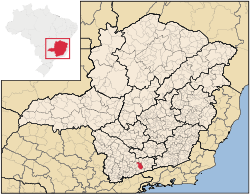
Baependi
Encyclopedia

Minas Gerais
Minas Gerais is one of the 26 states of Brazil, of which it is the second most populous, the third richest, and the fourth largest in area. Minas Gerais is the Brazilian state with the largest number of Presidents of Brazil, the current one, Dilma Rousseff, being one of them. The capital is the...
. Its population as of 2006 is estimated to be 18,173 people living in an altitude of 893 meters. The area of the municipality is 751.748 km². The city belongs to the mesoregion of Sul e Sudoeste de Minas and to the microregion of São Lourenço
São Lourenço
São Lourenço may refer to:*São Lourenço, Cape Verde, a village and a cove*São Lourenço, Minas Gerais, Brazil*São Lourenço , a parish in the municipality of Portalegre, Portugal...
.
History
According to some reports, mining occurred in the southern region from 1601. The conquest of Baependi happened, however, at the end of the seventeenth century, around 1692, when the São Paulo Delgado Antonio da Veiga, his son Joao da Veiga and uncle Miguel Garcia of the old master Manoel Garcia Velho, started from Taubaté, in search of gold. Crossing the Serra da Mantiqueira, they reached a site that called maependi (mbaé-pindi means "to open clearing" in Tupi-guarani).City remainder of the so-called cycle of Gold in Minas Gerais, Baependi has developed along the path of Estrada Real - the first major means of regular communication in Brazil - which link the region of mines to Paraty (RJ), port from where the rising gold toward Europe.
The Madeiran Tome Rodrigues Nogueira of O (1715), Captain-mor and Ombudsman of Quintos the "registration of the Mantiqueira" was one of the first residents of the site and was considered the founder of the city for doing the first building. The mining was, gradually, replaced by agriculture and cattle breeding. It is a great crop of tobacco, which was the center of Baependi producer of the Province of Minas Gerais and represented major source of wealth until the mid-nineteenth century.
Currently, the municipality's economy is based on agriculture, trade in handicrafts, marketing of stones, quartzite and tourism, as is the strong natural beauty of the city, surrounded by mountains, forests, rivers and numerous waterfalls. The craft is an important economic activity in Baependi. The pieces made in bamboo, straw, corn and tree trunk of coffee are distributed in large urban centers such as São Paulo, Rio de Janeiro, Belo Horizonte, capital of northeast.
Religion
Baependi has had a parish church since 1723. The ceremony of the Holy Week in Baependi has continued for over 200 years, being one of the most traditional of Minas GeraisMinas Gerais
Minas Gerais is one of the 26 states of Brazil, of which it is the second most populous, the third richest, and the fourth largest in area. Minas Gerais is the Brazilian state with the largest number of Presidents of Brazil, the current one, Dilma Rousseff, being one of them. The capital is the...
. The daily processions accompanied by banda music and choir, the representation of the Passion and Death of Jesus Christ, the corner of Veronica, the sound of bells and the sound of matracas, show the faith and tradition baependianas.
The temples, debruçados the slopes esguias, seem save the city and its inhabitants. The Shrine of N. Ms. of Conception, better known as Church of Nhá Chica
Nha Chica
Francisca de Paula de Jesus was born in 1808, in the Brazilian city of São João del-Rei, where she was also baptized. Later her family moved to the city of Baependi, where she lived until 1895....
, is the most visited by the faithful, which also delight with the architecture and the body of the Church N. Ms. of Montserrat (1754). The churches baependianas - the Mother, Our Lady of Good Death (1815) and Rosario (1820) - tombadas by and Artistic Heritage, represent assets of great value to a nation that considers Nhá Chica its highest spiritual heritage.

